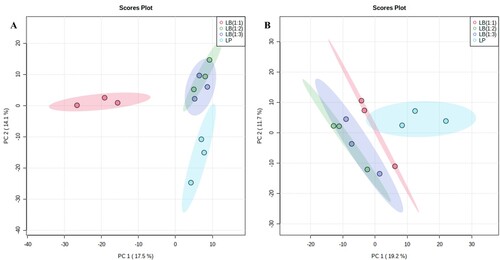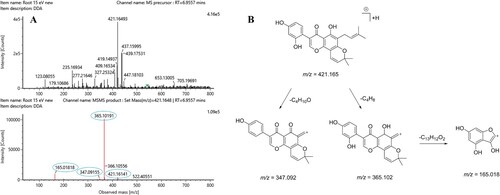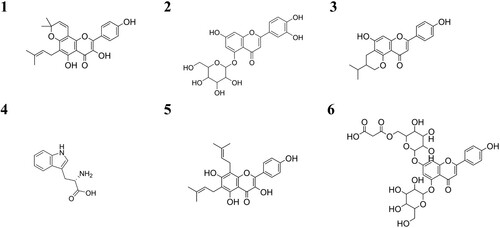Figures & data
Figure 1. Timeline of the pot experiment. The watering system is marked with a blue X in the centre of each pot. Round seeds are lupin and long oval seeds are barley. Four pots are shown: LP, LB(1:1), LB(1:2) and LB(1:3). Day 1: Daily irrigation of all pots is initiated. Day 6: Inoculation of lupin seeds. Day 7: Sowing of 8 lupin seeds. Day 17: Reduction to 6 lupin seeds and sowing of 8, 16 and 22 barley seeds, respectively. Day 31: Reduction to 6, 12 and 18 barley seeds, respectively. Day 53: Harvest of both lupin and barley plants.

Figure 2. PCA score plot of the features detected in lupin roots in positive (A) and negative (B) ionisation mode, respectively, in LC-QTOF MS analysis.

Table 1. Overview of annotated metabolites in lupin roots and shoots affected by intercropping with barley (LP compared to LB(1:3)).
Figure 3. Example of the structural elucidation following MS/MS fragmentation of metabolite 1 with spectral peaks in MS1 (top) and MS2 (bottom) (A) representing the three structural fragments, (m/z 165.018, 365.102 and 347.092) and the precursor ion (m/z 421.165) (B).

Figure 4. Proposed chemical structure of the six metabolites altered by the presence of barley in a lupin cropping system. Metabolite 1: a branched flavonoid – here kaempferol as backbone (1), metabolite 2: a flavonoid with a hexose – here luteolin as backbone with glucoside (2), metabolite 3: a branched flavonoid – here apigenin as backbone (3), metabolite 4: tryptophan (4), metabolite 5: a branched flavonoid – here kaempferol as backbone (5) and metabolite 6: a flavonoid with two hexoses and a malonyl – here apigenin as backbone with a diglucoside, one of which with a malonic acid ester (6).

